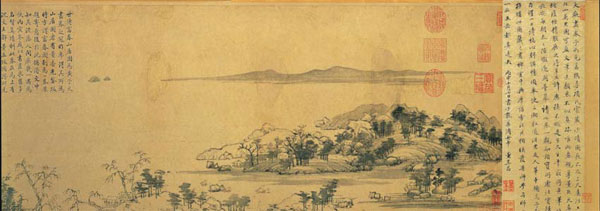The fine art of fighting cancer
Updated: 2016-09-23 08:01
By Fu Jing in Brussels(China Daily Europe)
|
|||||||||
Therese Zaremba-Martin is 71 but looks much younger. The Belgian puts this down, in part, to her fondness for painting Chinese mountains and rivers, which she says has also helped her recover from treatment for cancer.
"Painting has given me energy and force, especially when I was very ill last year," she says from a studio in Brussels where she is learning painting techniques from a Chinese master.
She and Zhang Wenhai roll out a copy she made of the classic masterpiece Dwelling in Fuchun Mountain, the original of which was created by Huang Gongwang six centuries ago.
|
Part of the classic masterpiece Dwelling in Fuchun Mountain, by Huang Gongwang of the Yuan Dynasty (1269-1354). Fu Jing / China Daily |
|
Belgian artist Therese Zaremba-Martin and her Chinese master Zhang Wenhai roll out a copy of the painting. |
Her version took three years to complete, roughly the same length of time that Huang spent on the original, which he painted in old age between 1347 and 1350.
Huang's painting, considered to be among the 10 best examples of ancient Chinese art, captures the magnificent early autumn view of the banks of Zhejiang province's Fuchun River.
In June last year, when she had finished three-quarters of her painting, Zaremba-Martin was diagnosed with breast cancer.
"Of course, it was depressing, but I also started thinking of life, the meaning of life, and the importance of people," she says.
Her family and friends have been helpful and supportive, and she is getting as close as she can to nature, fresh air and friends.
After taking a break from painting for three or four months last year while she was weak and undergoing treatment, she said her mind drifted back to finishing her copy of the masterpiece.
Her teacher Zhang, who is 35 and originally from Shanghai, is a graduate of the Royal Academy of Fine Arts in Brussels and offers private tuition in Chinese calligraphy and painting.
He says he too thought painting might help and suggested she use it as "part of the treatment formula".
Zaremba-Martin, though still weak, picked up her brush. "Every time I finished one part, I had to go back to see if I need more strokes. Then suddenly, the brush, the ink and the energy became different," she says. "I had the impression I was no longer painting, and it was my brush going along the way. It was right, but very strange."
Zaremba-Martin, who has worked as a freelance interpreter, mainly in German, French and English, since she was 26, is married to an interpreter who she met in Germany in 1972. They have three children and five grandchildren.
She has loved Oriental art since she was young but initially could not tell the difference between Chinese and Japanese paintings.
"If I found a book with such paintings, I always wanted to buy it and I told my relatives to buy such books for my birthdays," she says.
She learned how to paint at school but has only really focused on her art in recent years.
"It was my daughter who said, you have spoken about it enough and you need to start to do it," she says.
At first, she started to learn calligraphy. Then, in 2008, she met Zhang, who initially introduced her to traditional Chinese wood carving.
She tried it for one week and liked it but told Zhang she really wanted to learn about traditional Chinese painting.
Zhang not only teaches her about art technique but also about philosophy, She says.
She has finished reading two Chinese classics, Water Margin and Journey to the West, which also help her better understand the meaning of the paintings.
Yao Yueyang contributed to this story.
fujing@chinadailycom.cn
(China Daily European Weekly 09/23/2016 page21)
Today's Top News
ODI led for first time by private firms
Nanjing's culture and creativity on display in London
State of emergency declared in US city amid protests
Universities given boost in rankings
Demand for Mandarin rises in UK
China 'capable of keeping medium-to-high growth'
Li tells Obama of opposition to THAAD deployment
Greek vows to improve refugee situation on island
Hot Topics
Lunar probe , China growth forecasts, Emission rules get tougher, China seen through 'colored lens', International board,
Editor's Picks

|

|

|

|

|

|









